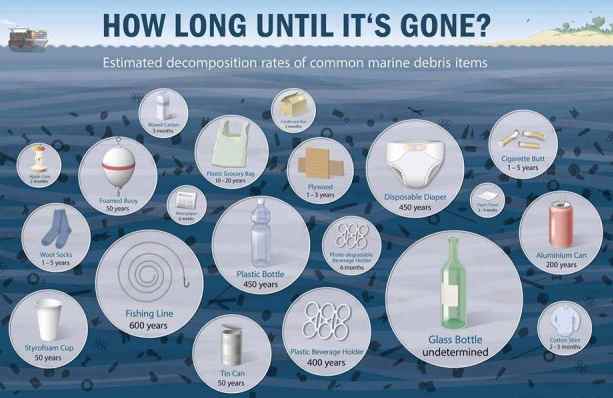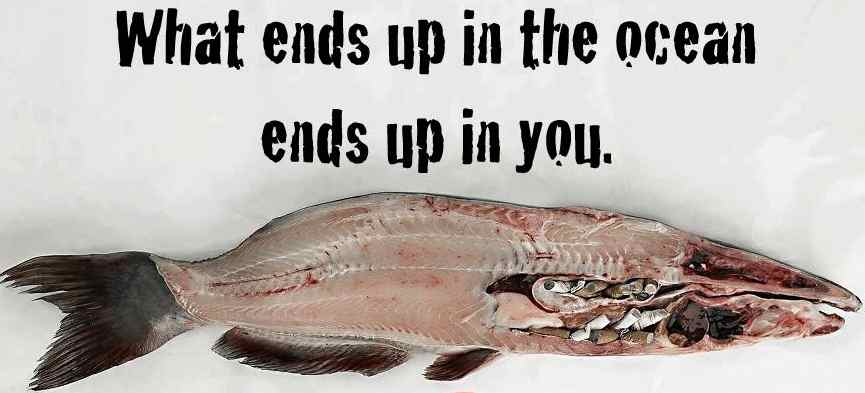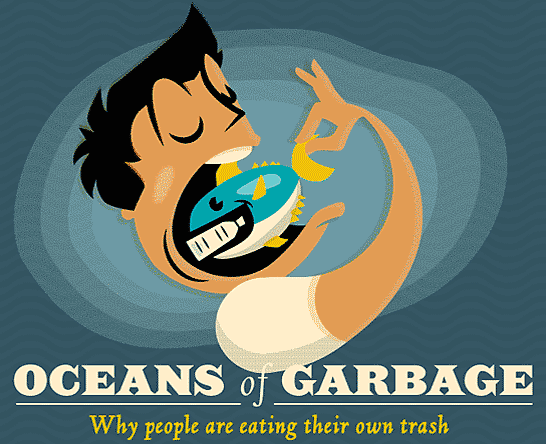After
the last tree has been cut down, after the last river has been
poisoned,
after the last fish has been caught, only then will you find
that money cannot be eaten.
Cree prophecy
Maya Weeks is in it for the oceans. She is currently
writing a book about the gendered violence of marine debris
as byproduct of global capitalism. She blogs at anaturalhistoryofcolours.tumblr.com
and tweets at @looseuterus.The
Myth of the Garbage Patch was originally published at The
New Inquiry.
You
are probably already aware of the mass of garbage in the Pacific
Ocean, commonly known as the Great Pacific Garbage Patch or
Trash Vortex or Trash Gyre or some combination thereof. You
are probably familiar with the description wherein this Garbage
Patch/Vortex/Gyre is represented as an island of trash roughly
twice the size of Texas floating somewhere in the vicinity of
Hawai’i. You may have heard that 80% of the waste comprising
the Garbage Patch is plastic and have probably seen images of
dead albatrosses --  dead,
you will have been told, because of the whole plastic bottle
caps and lighters it mistook for food -- or dead jellyfish or
seals or sea lions or sea turtles or whales. Somewhere in this
mesh of information lies the first myth of the Garbage Patch.
dead,
you will have been told, because of the whole plastic bottle
caps and lighters it mistook for food -- or dead jellyfish or
seals or sea lions or sea turtles or whales. Somewhere in this
mesh of information lies the first myth of the Garbage Patch.
Missing
from that myth is a key series of related facts. That the debris
breaks down into microscopic pieces. That the garbage actually
constitutes more of a ‘plastic soup’ than any kind
of patch or island, and that its pollutants are, as a result,
widely dispersed. That what breaks down doesn’t remain
solely in the Garbage Patch; that anywhere ocean currents converge
is this toxic soup. This soup is suffused with Bisphenol A,
pthalates, polychlorinated biphenyls, persistent organic pollutants,
and other remainders from discarded commodities that contribute
directly to the ocean acidification, killing fragile ecosystems
from the coral-based Great Barrier Reef off of Australia to
Inuit territories in the Arctic. Far from a solid, particulate
island, the Garbage Patch is, along with the rest of the ocean’s
water, in constant motion. And it doesn’t necessarily
stay at surface. In 2010 a team of ecologists, studying ocean
garbage patches, observed that the plastic in them accounted
for only a small portion of the plastic that has been produced
since World War II. “[W]e don’t know what this plastic
is doing,” said marine biologist Andres Cozar Cabañas,
who worked on the team, adding only that it “is somewhere
-- in the ocean life, in the depths.”
We
hear reports about the effects of this dispersed waste all the
time. Hundreds of thousands of marine birds, fish, reptiles
and mammals die annually from ingesting or becoming entangled
in marine debris. Sharks, hungry because their prey is dying
off, have been attacking humans more often in the last two decades
than ever previously. In Alaska, sperm whales are resorting
to snagging black cod from the lines of fishermen. Polymer fibers
get embedded on corals and on the ocean floor, where they suffocate
the coral communities that process carbon dioxide and release
pollutants into the food web. The number of anoxic zones --
places where oxygen levels have dipped too low to support life
-- keeps rising; the quarter of the planet’s biodiversity
whose home is the coral reef is rapidly decreasing; and a team
of ecologists have predicted the extinction of all saltwater
fish by 2048.
Yet
even at their most apocalyptic, these reports have the feel
of isolated incidents rather than the various manifestations
of a late capitalist global system in which value’s counterpart
is increasingly and necessarily waste. Under this system, the
overwhelming majority of goods that make convenient consumer
culture possible are composed of manmade polymers, including
but not limited to whiskey bottles, water and soda bottles,
bottle caps, six-pack loops, industrial felt, fishing rope,
nylon flags, fleece sweaters, shoes, purses, eating utensils,
cups, bowls, cell phones, computers, printers, furniture, toys,
and, of course, plastic bags.
We
weren’t always so surrounded with the stuff. Goods and
tools used to be made to last a lifetime out of organic materials
such as metal, wood and earthenware; when objects broke they
were repaired for as long as possible, then thrown to the earth
to decompose. Disposable income in the booming post-World War
II economy made it much easier for people used to living with
limited means to simply acquire new goods instead of continuing
to reuse old ones. According to Jeffrey Meikle, author of American
Plastic: A Cultural History, after World War II resin makers
“mounted a major educational effort to accommodate the
consumer to new, previously unknown plastics. People neither
naturally gravitated to the stuff, nor did they instinctively
throw it away, so the industry also had to insulate consumers
to plastic’s disposability.” It’s no coincidence
that the escalation of the abovementioned effects -- the rise
in hungry whales, shark attacks, dying coral, anoxic zones and
so on and so forth -- have coincided with quadrupled plastics
production since the massive neoliberal deregulation of the
1980s.
From
our vantage point within capitalism, it is difficult to identify
the origins of this plastic and see where it ends up in the
waste stream. It is difficult to trace a disposable container
of strawberries back to a multinational biotech corporation
and its compulsory distribution of genetically modified seeds
and pesticides to the resulting runoff that eventually washes
to the ocean. It can be a challenge to chart the paths of the
independently-contracted trucks that carry such containers to
the ships that export U.S. recyclables to Asia, never mind account
for where the waste goes upon landing. It’s hard to keep
in mind that the bunker oil fueling those ships and the processed
petroleum in that strawberry container might have been mined
by the same London-based oil company, and harder still to tease
out the many and various geopolitical infrastructures -- including
the surveillance cameras, barbed wire, and armed security checkpoints
of the global security state, for just one example -- that prop
up that company’s transnational holdings. It is easy to
treat the interdependence of these dynamics as too complex to
grasp. But to shy away from this complexity is to help maintain
the capitalist status quo.
While
we stay busy not seeing the complex market interplay that produces
and then abandons our plastics, the first myth of the Garbage
Patch continues apace. Liberal do-gooders advocate for the use
of massive nets to gather ocean plastic, imagining an easy extraction
of waste from environment. Meanwhile, back on land in the wealthiest
communities, people are urged to purchase solutions. Whole Foods
invites customers to eat in bulk from the salad bar with a bioplastic
fork derived from renewable sources, which, even if it manages
to break down in the oxygen-free environment of the sanitary
landfill, produces methane, a greenhouse gas twenty-three times
more potent than carbon dioxide, in the process. The startup
Shorecombers sells “Trash Blasting Tourism,” seven-day
trash cleanup vacations, half of which is spent online. Clothing
made from recycled plastics is available from brands like G
Star Raw and Patagonia, but these articles still shed microplastics
into the waste stream every time they are washed.
 Green
capitalism is still capitalism, fundamentally unsustainable
and exploitative, and while the world’s most privileged
consumers insulate themselves, its devastating ecological effects
hit poor communities living in the world’s severest locations
especially hard. While Americans and Europeans with money can
fill their diets with certified ‘ethical’ fish,
this isn’t really an option for native people in the circumpolar
North -- including the Inuit of Greenland and Canada, the Aleuts,
Yup’ik, and Inupiat of Alaska, the Chukchi and other tribes
of Siberia, or the Saami of Scandinavia and western Russia --
whose cultures as well as diets depend on the ocean. Living,
working and fishing at the edge of glacial sheets, these people
can’t really choose not to eat fish with plastic embedded
in their scales, or the exorbitant concentrations of pollutants
in the larger marine mammals high up in the food web -- the
ringed seals, walruses, narwhals, and beluga whales -- that
are both dietary staples and sources of clothing and building
materials. Because of the cold and low Northern sunlight, pollutants
break down especially slowly – over the course of decades
or even centuries, according to Marla Cone, author of Silent
Snow: The Slow Poisoning of the Arctic. Cone has also noted
that even in the 80s Arctic mothers had seven times more PCBs
in their milk than their counterparts in Canadian cities.
Green
capitalism is still capitalism, fundamentally unsustainable
and exploitative, and while the world’s most privileged
consumers insulate themselves, its devastating ecological effects
hit poor communities living in the world’s severest locations
especially hard. While Americans and Europeans with money can
fill their diets with certified ‘ethical’ fish,
this isn’t really an option for native people in the circumpolar
North -- including the Inuit of Greenland and Canada, the Aleuts,
Yup’ik, and Inupiat of Alaska, the Chukchi and other tribes
of Siberia, or the Saami of Scandinavia and western Russia --
whose cultures as well as diets depend on the ocean. Living,
working and fishing at the edge of glacial sheets, these people
can’t really choose not to eat fish with plastic embedded
in their scales, or the exorbitant concentrations of pollutants
in the larger marine mammals high up in the food web -- the
ringed seals, walruses, narwhals, and beluga whales -- that
are both dietary staples and sources of clothing and building
materials. Because of the cold and low Northern sunlight, pollutants
break down especially slowly – over the course of decades
or even centuries, according to Marla Cone, author of Silent
Snow: The Slow Poisoning of the Arctic. Cone has also noted
that even in the 80s Arctic mothers had seven times more PCBs
in their milk than their counterparts in Canadian cities.
“At
the periphery of the global capitalist system,” writes
Chris Chen in “The Limit Point of Capitalist Inequality,”
“capital now renews ‘race’ by creating vast
superfluous . . . populations from the . . . descendants of
the enslaved and colonized.” It’s no accident that
plastic pollutants pool in the communities that capitalism has
historically treated -- and continues to treat -- as refuse.
Somewhere in that convergence -- in the attitude that everything
that gets thrown away stays far away -- lies the second myth
of the Garbage Patch.
“It’s
been the end of the world for somebody all along,” says
writer, spoken-word artist, and indigenous academic Leanne Simpson.
Recent studies show that marine pollution and ocean acidification,
once thought a separate if parallel disaster to climate change,
are in fact contributing to global climate disruption, suggesting
that, ecologically speaking, there is no such thing as somebody
else’s end of the world. Although the idea of the Garbage
Patch is entrenched in the collective imagination, we can use
language to help dislodge it. We can begin this process by rejecting
the myths of the Great Pacific Garbage Patch. We must stop thinking
and talking in terms of an island that captures everything we
throw away in a faraway fever dream of plastic bags and marine
birds, and begin to map out the deeply interconnected web of
plants, animals, humans, and non-living things in which we actually
exist. We must recognize that capitalism depends on us not seeing
this web and that capitalism will never fix marine pollution
or climate change. As long as, like Andres Cozar Cabañas’
missing plastic, there are lives whose fates remain distant
and unaccounted for, everybody’s fates are at risk.